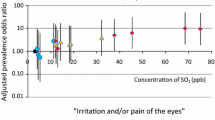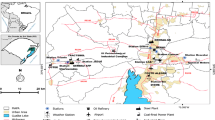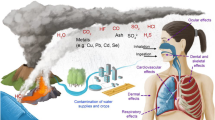Abstract
Sulfur dioxide measured at the Visitor’s Center of Hawai’i Volcanoes National Park, USA exhibits seasonal and diurnal patterns and is sensitive to rainfall, but the relationship between wind direction and SO2 is too inconsistent to support deterministic predictions of hourly SO2 based on hourly wind direction. Although SO2 at the Visitor Center has usually been below regulatory levels, high SO2 levels and adverse health effects remain a concern. This investigation identified patterns in hourly SO2 based on wind direction, time of day, month, and rainfall occurrence using 4 years of hourly data. Empirical probabilities were investigated using a Bayesian approach. Winds from the volcanic vents were rare, but when they did occur SO2 was elevated about half of the time. Conversely, half of the hours with elevated SO2 occurred when volcanic vents were not directly upwind. Episodes of elevated SO2 tended to occur during the months of November–March and between 8:00 a.m. and 5:00 p.m. Rainfall was associated with a marked reduction in SO2 (29–81% depending on wind direction). Individuals that wish to avoid exposure to volcanic fumes can take these patterns into account.










Similar content being viewed by others
References
Alarie YC, Krumm AA, Busey WM, Urich CE, Kantz RJ (1975) Long-term exposure to sulfur dioxide, sulfuric acid mist, fly ash, and their mixtures: results of studies in monkeys and guinea pigs. Arch Environ Health 30(5):254–62
Amdur MO, Chen LC (1989) Furnace-generated acid aerosols: speciation and pulmonary effects. Environ. Health Perspect 79:147–150
Casadevall TJ, Stokes JB, Greenland LP, Malinconico LL, Casadevall JR, Furukawa BT (1987) SO2 and CO2 emission rates at Kīlauea Volcano, 1979–1984. In: Decker RW, Wright TL, Stauffer PH (eds) Volcanism in Hawai’i: U.S. Geological Survey Professional Paper 1350, pp 771–780
Chen Y, Nash AJ (1994) Diurnal variation of surface airflow and rainfall frequencies on the Island of Hawai’i. Month Weather Rev 122:34–56
Chen Y (1999) Study on the effect of wind direction on emergency room visits for asthma among children in Hilo, Hawai’i Island. Masters Thesis, University of Hawai’i at Mānoa
Clarke AD, Porter JV (1996) Size distribution, optical effects, and spatial variability. Hawai’i Med J 55(3):45
Elias T, Sutton AJ, Stokes JB, Casadevall TC (1998) Sulfur dioxide emission rates of Kīlauea Volcano, Hawai’i 1979–1997. US Geological Survey Open-File Report 98–462
Elias T, Sutton AJ (2002) Sulfur dioxide emission rates of Kīlauea Volcano, Hawai’i, an Update; 1998–2001. US Geological Survey Open-File Report 02–460
Gibson BA (2002) A geotechniques-based exploratory investigation of vog impacts to the environmental system on Hawai’i Island. PhD dissertation, University of Oklahoma, USA
Greenland LP (1987) Composition of gases from the 1984 eruption of Mauna Loa volcano SO2. In: Decker RW, Wright TL, Stauffer PH (eds) Volcanism in Hawai’i: U.S. Geological Survey Professional Paper 1350, pp 781–790
Hackney JD, Linn WS, Avol EL (1989) Acid fog: effects on respiratory function and symptoms in healthy and asthmatic volunteers. Environ Health Perspect 79:159–62
Heliker C, Swanson DA, Takahashi TJ (2003) The Pu’u ’Ō’ō-Kūpaianaha eruption of Kīlauea Volcano, Hawai’i. US. Geological Survey Professional Paper 1676
Hinkley TK, Lamothe PJ, Wilson SA, Finnegan DL, Gerlach TM (1999) Metal emissions from Kīlauea, and a suggested revision of the estimated worldwide metal output by quiescent degassing of volcanoes. Earth Planet Sci Lett 170(3):315–325
Hollingshead AT, Businger S, Draxler R, Porter J, Stevens D (2003) Dispersion modeling of the Kīlauea plume. Bound Layer Meteorol 108(1):121–145
Mannino DSM, Ruben S, Holschuh FC, Holschuh TC, Wilson ND, Holschuh T (1996) Emergency department visits and hospitalizations for respiratory disease on the island of Hawai’i, 1981–1991. Hawai’i Med J 55(3):48–54
Michaud J-P, Grove JS, Krupitsky D (2004) Emergency department visits and “vog” related air quality in Hilo, Hawai’i. Environ Res 95:11–19
Michaud J-P, Krupitsky D, Grove JS, Anderson BS (2005) Volcano related atmospheric toxicants in Hilo and Hawai’i Volcanoes National Park: Implications for human health. NeuroToxicology 26:555–563
Morrow JW (2000) A longitudinal study to characterize Hawai’i’s volcanic aerosol and investigate its potential acute effects on asthmatic children. PhD dissertation, University of Hawai’i at Mānoa, USA
Notcutt G, Davies F (1993) Dispersion of gaseous volcanogenic fluoride, Island of Hawai’i. J Volcanol Geotherm Res 56(1–2):125–131
Porter JN, Businger S, Watanabe D, Baerman A, Motell C (2000) Studies of the Hawai’i Volcano plume from satellite and models. International Geoscience and Remote Sensing Symposium, held in Honolulu, HI, United States, July 24–28, 2000, 2000(4):1649–1651
Rosenfeld D (2000) Suppression of rain and snow by urban and industrial air pollution. Science 287:1793–1796
Schnell R (1996) Atmospheric structure around the Big Island and how it affects vog flow. Hawai’i Med J 55(3):45
Siegel SM, Siegel BZ (1984) First estimate of annual mercury flux at the Kīlauea main vent. Nature 309:146–147
Winner W, Mooney H (1980) Responses of Hawaiian plants to volcanic sulfur dioxide: stomatal behavior and foliar injury. Science 210:789–791
Acknowledgment
Air quality data, wind data, and rainfall data were collected by Hawai’i Volcanoes National Park, and obtained from the National Park Service Air Resources Division. This study was partially funded by the Centers for Disease Control and Prevention via the Hawai’i Department of Health (Grant H2S/CCT913731) and in no way reflects the opinions or policies of these agencies or their representatives.
Author information
Authors and Affiliations
Corresponding author
Rights and permissions
About this article
Cite this article
Michaud, J.D., Michaud, JP. & Krupitsky, D. Temporal variability in SO2 exposures at Hawai’i Volcanoes National Park, USA. Environ Geol 52, 81–92 (2007). https://doi.org/10.1007/s00254-006-0459-y
Received:
Accepted:
Published:
Issue Date:
DOI: https://doi.org/10.1007/s00254-006-0459-y




